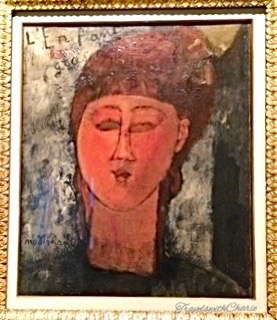Supper at Emmaus, Michaelangelo Meresi Da Caravaggio, 1606
One of two paintings created by Caravaggio, this painting from 1606 was completed around the time the artist fled from Rome after he killed Ranuccio Tomassoni, a pimp, in a dispute over a tennis match. Other reports suggest that the rivalry between the two over a prostitute, Fellide Melandroni, was the underlying reason for the brawl.
This painting is far more somber than an earlier (1601) work now hanging in the National Gallery in London. Notice the dark background and how light floods the scene to illuminate the faces of Jesus and his companions. This stark contrast between light and dark is called chiaroscuro and the application of a dark background or shadow is referred to as tenebrism. Chiaroscuro adds depth to the composition and creates a dramatic effect. Feel how the painting pulls the viewer to the open space in front of Jesus and to that moment when He blesses the food on the table.
Crucifixion, Gentile da Fabriano, 1408
Gentile da Fabriano is considered one of the most important artists of International Gothic art which is characterized by elongated figures, decorative color and gold, fluid lines and elegance fit for the court. Gentile had many commissions in the Veneto but he moved to Florence in 1420 where he worked for the powerful and wealthy Strozzi family for whom he painted the Adoration of the Magi in 1423 for the Strozzi altarpiece. He then moved to Rome in 1427 when Pope Martin V commissioned him to decorate the nave of St. John Lateran. Unfortunately he died before the end of 1427.Madonna and Child, Giovanni Bellini, 1510
Giovanni Bellini was about 80 years old when he painted this Madonna and Child. Considered the master of light and color, Bellini ushered in the golden age of Venetian painting along with his pupils, Giorgione and Titian.
Self portrait, Sofonisba Anguissola, 1560-1561
Sofonisba Anguissola was an Italian painter during the late Renaissance era, one of a handful of women artists from that period. She became a lady-in-waiting to the queen of Spain, Elizabeth of Valois, wife of Philip II and was also an attendant to the Infanta Isabella Clara Eugenia. Many of her paintings from her stay in Spain were lost to a fire at the court in the 17th century. She returned to Italy in 1579 and settled in Genoa with her second husband.
Sofonisba’s father was a member of the nobility and through his influence, she had the good fortune to receive the encouragement of Michaelangelo for her artistic endeavors. When she was in her 90s, she met Anthony Van Dyck who recorded his visit by sketching her.
Riot in the Galleria, Umberto Boccioni, 1910
Umberto Boccioni was one of the leading proponents of the Futurism movement in Italy. Futurism art defines the dynamic movement and energy of modern life. Boccioni clearly demonstrates this in Riot in the Galleria and in his sculptural work, Unique Forms of Continuity in Space.
Enfant Gras (Fat Child), Amedeo Modigliani, 1915
Nu Couché, a nude painting by Amedeo Modigliani sold for $170.4 million at a Christie’s auction in November 2015, the second highest price paid for a painting at an auction. But Modigliani died a pauper when he was only 35 years old from tubercular meningitis. Yet he produced an incomparable body of artworks including sculptures despite his weakened health having had pleurisy at 11, typhus at 14 and tuberculosis at 16 years of age followed by alcohol and drugs during his Paris years. Poor health did not deter him however, from pursuing his dream. He lived up to his motto, “It is your duty in life to pursue your dream.”
Chapel of St. Joseph
The frescoes from the Chapel of St. Joseph were taken from Santa Maria Della Pace and reassembled at the Brera in the 19th century. The fresco cycle depicts scenes from the early life of Mary including St. Joseph’s Dream by Bernardo Luini from 1520-21 where an angel is shown convincing Joseph to marry Mary.

Mocchirolo Chapel
These frescoes were taken from the Oratory of Porro in Mocchirolo and are dated around 1360-70. It was brought and reassembled at the Brera Museum in the 1950s.
** I don’t have an image to post of the The Marriage of the Virgin (1504) by Raphael. This is one of many treasures at the Brera that should not be missed. You can find it here: https://pinacotecabrera.org/en/collezione-online/opere/the-marriage-of-the-virgin/
How to get there:
Via Brera, 28
Milan, Italy
The closest metro stations are Lanza (M2 line), Montenapoleone (M3) or Carolina (M1).
www.pinacotecabrera.org
*****
Images by TravelswithCharie






